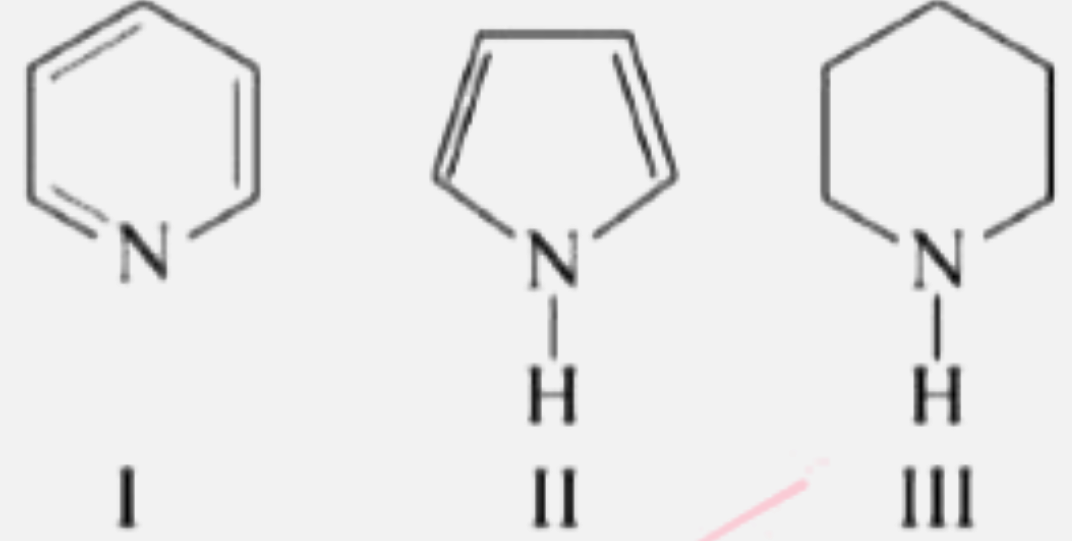The one which is the least basic
NH3
C6H5NH2
(C6H5)3N
(C6H5)2NH
The correct Answer is:C
To determine which amine is the least basic among the given options, we need to analyze the basicity of each compound based on their structure and the presence of electron-withdrawing or electron-donating groups.
1. Understanding Basicity:
Basicity in amines is primarily determined by the availability of the lone pair of electrons on the nitrogen atom to accept protons (H⁺). The more available the lone pair, the stronger the base.
2. Analyzing Ammonia (NH₃):
- Ammonia has a lone pair of electrons on nitrogen that is readily available for donation.
- Therefore, ammonia is a strong base.
3. Analyzing Aniline (C₆H₅NH₂):
- In aniline, one hydrogen atom of ammonia is replaced by a benzene ring.
- The lone pair of electrons on nitrogen can participate in resonance with the benzene ring, leading to delocalization of the electrons.
- This delocalization reduces the availability of the lone pair for protonation, making aniline less basic than ammonia.
4. Analyzing Diphenylamine (C₆H₅NH(C₆H₅)):
- In diphenylamine, two hydrogen atoms of ammonia are replaced by two benzene rings.
- The presence of two electron-withdrawing benzene rings further delocalizes the lone pair on nitrogen, making it even less available for donation than aniline.
- Thus, diphenylamine is less basic than aniline.
5. Analyzing Triphenylamine (C₆H₅)₃N:
- In triphenylamine, all three hydrogen atoms of ammonia are replaced by three benzene rings.
- The lone pair of nitrogen is highly delocalized due to resonance with all three benzene rings, making it the least available for donation.
- Therefore, triphenylamine is the least basic among all the options.
Conclusion:
The compound that is the least basic is Triphenylamine (C₆H₅)₃N.
---
Basicity in amines is primarily determined by the availability of the lone pair of electrons on the nitrogen atom to accept protons (H⁺). The more available the lone pair, the stronger the base.
- Ammonia has a lone pair of electrons on nitrogen that is readily available for donation.
- Therefore, ammonia is a strong base.
- In aniline, one hydrogen atom of ammonia is replaced by a benzene ring.
- The lone pair of electrons on nitrogen can participate in resonance with the benzene ring, leading to delocalization of the electrons.
- This delocalization reduces the availability of the lone pair for protonation, making aniline less basic than ammonia.
- In diphenylamine, two hydrogen atoms of ammonia are replaced by two benzene rings.
- The presence of two electron-withdrawing benzene rings further delocalizes the lone pair on nitrogen, making it even less available for donation than aniline.
- Thus, diphenylamine is less basic than aniline.
- In triphenylamine, all three hydrogen atoms of ammonia are replaced by three benzene rings.
- The lone pair of nitrogen is highly delocalized due to resonance with all three benzene rings, making it the least available for donation.
- Therefore, triphenylamine is the least basic among all the options.
The compound that is the least basic is Triphenylamine (C₆H₅)₃N.
Topper's Solved these Questions
- AMINES BOOK - AAKASH INSTITUTE ENGLISHCHAPTER - AMINES EXERCISE - Assignment Section B (Objective Type Questions) one option is correct
23 Videos
- AMINES BOOK - AAKASH INSTITUTE ENGLISHCHAPTER - AMINES EXERCISE - Assignment Section C (Objective type questions more than one options are correct)
12 Videos
- AMINES BOOK - AAKASH INSTITUTE ENGLISHCHAPTER - AMINES EXERCISE - Try Yourself
10 Videos
- ALDEHYDES, KETONES AND CARBOXYLIC ACIDS BOOK - AAKASH INSTITUTE ENGLISHCHAPTER - ALDEHYDES, KETONES AND CARBOXYLIC ACIDS EXERCISE - Try Yourself
20 Videos
- BIOMOLECULESBOOK - AAKASH INSTITUTE ENGLISHCHAPTER - BIOMOLECULESEXERCISE - EXERCISE (ASSIGNMENT) SECTION - D Assertion - Reason Type Questions
5 Videos
Similar Questions
Knowledge Check
Which one among the following is the least basic?
ACH3NH2B..NH3CCH3CH2NH2D
Among the following which is the least basic
View SolutionThe one which is most basic out of the following
View SolutionWhich one is least basic ?
View SolutionThe one which has least mass, is
View SolutionWhich one among the following is the least basic:
View SolutionWhich of the following is the least basic?
View SolutionWhich the following amines is the least basic ?

View Solution
